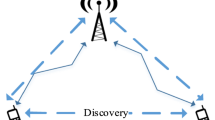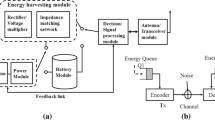Abstract
In a wireless self-organizing and the network-assisted Device-to-Device (D2D) network, proximal Device Discovery (DD) plays a noteworthy role. It is the foundation for self-governing, coverage expansion and performance improvement for example, cooperative and multi-hop transmission. Energy efficiency and discovery accuracy are critical performance measures for proximal DD. A novel DD procedure using Non-orthogonal Multiple Access based Multi-user Shared Access (MUSA) is proposed in this article for network-assisted D2D communication. The proposed shared access scheme uses a complex spreading pattern to accommodate dense device discovery and enhance discovery distance in the cellular systems. A discovery signal shared access method with supplementary schemes for multi-user detection is also designed. With MUSA and its spreading pattern demodulation, 12% enhanced energy efficiency, and 98% overall improved accuracy is achieved contrasted with the customary DD methods.



Similar content being viewed by others
References
Hayat, O., et al. (2019). In-band device to device (d2d) communication and device discovery: A survey. Wireless Personal Communication, 106(2), 451–472.
Waqas, M., et al. (2018). Mobility assisted content transmission for device-to-device communication underlaying cellular networks. IEEE Transactions on Vehicular Technology, 67(7), 6410–6423.
Doumiati, S., et al. (2016). Analytical study of a service discovery system based on an LTE-A D2D implementation. Physical Communication, 2016(19), 145–162.
Wang, Y., et al. (2019). A novel energy-efficient neighbor discovery procedure in a wireless self-organization network. Information Sciences, 476(1), 429–438.
Halima, B. Â., et al. (2019). Optimal routing and one hop routing for d2d communications in the presence of mutual interference. Telecommunication Systems, 71(1), 55–64.
Hayat, O., et al. (2020). A survey on security and privacy challenges in device discovery for next-generation systems. IEEE Access, 8(2020), 84584–84603.
Hayat, O., et al. (2019). Device discovery in D2D communication: A survey. IEEE Access, 7(2019), 131114–131134.
Wu, X. Z., et al. (2013). Flashlinq: A synchronous distributed scheduler for peer-to-peer ad hoc networks. IEEE-ACM Transactions on Networking, 21(4), 1215–1228.
Hayat, O., et al. (2020). Sector scanning algorithm (SSA) for device discovery in D2D communication. International Journal of Electronics, 1, 1–19.
Wunder, G., et al. (2014). 5GNOW: Non-orthogonal, asynchronous waveforms for future mobile applications. IEEE Communications Magazine, 52(2), 97–105.
Kim, H., et al. (2017). Multiple access for 5g new radio: Categorization, evaluation, and challenges, pp. 1–9. arXiv preprint arXiv:1703.09042.
Lim, C., et al. (2018). Trellis tone modulation multiple-access for peer discovery in D2D networks. Sensors, 18(4), 1228–1238.
Hayat, O., et al. (2018). Device discovery for D2D communication in in-band cellular networks using sphere decoder like (SDL) algorithm. EURASIP Journal on Wireless Communications and Networking, 1, 2–7.
Baccelli, F., et al. (2012). On the design of device-to-device autonomous discovery. In 4th IEEE international conference on communication systems and networks (COMSNETS), Bangalore (pp. 1–9).
Luo, C., & Zhang, F.-L. (2016). Signal processing for 5G: Algorithms and implementations. Chichester: Wiley.
Tao, Y., et al. (2015). A survey: Several technologies of non-orthogonal transmission for 5G. China Communications, 12(10), 1–15.
Lianghai, J., et al. (2017). Applying device-to-device communication to enhance IoT services. IEEE Communications Standards Magazine, 1(2), 85–91.
Madani, N., et al. (2018). Performance analysis of non-orthogonal multiple access with underlaid device-to-device communications. IEEE Access, 2018(6), 39820–39826.
Yuan, Z. et al. (2016). Multi-user shared access for internet of things. In 83rd IEEE vehicular technology conference (VTC Spring), Nanjing (pp. 1–5).
Kazmi, S. M. A., et al. (2018). Coordinated device-to-device communication with non-orthogonal multiple access in future wireless cellular networks. IEEE Access, 2018(6), 39860–39875.
Fang, F., et al. (2016). Energy-efficient resource allocation for downlink non-orthogonal multiple access network. IEEE Transactions on Communications, 64(9), 3722–3732.
Pei, L., et al. (2018). Energy-efficient D2D communications underlaying NOMA-based networks with energy harvesting. IEEE Communications Letters, 22(5), 914–917.
Hayat, O., et al. (2017). Cooperative device-to-device discovery model for multiuser and OFDMA network base neighbour discovery in in-band 5G cellular networks. Wireless Personal Communications, 97(3), 4681–4695.
Acknowledgements
The authors would like to express their gratitude to the Ministry of Higher Education (MOHE) in Malaysia and Universiti Teknologi Malaysia (UTM) for providing the financial support for this research through the HICoe Research Grant Scheme (R. J130000.7851.4J412). The Grant is managed by Research Management Centre (RMC) at UTM.
Author information
Authors and Affiliations
Corresponding author
Additional information
Publisher's Note
Springer Nature remains neutral with regard to jurisdictional claims in published maps and institutional affiliations.
Rights and permissions
About this article
Cite this article
Hayat, O., Ngah, R. & Hashim, S.Z.M. Multi-user Shared Access (MUSA) procedure for device discovery in D2D communication. Telecommun Syst 76, 291–297 (2021). https://doi.org/10.1007/s11235-020-00716-3
Published:
Issue Date:
DOI: https://doi.org/10.1007/s11235-020-00716-3




